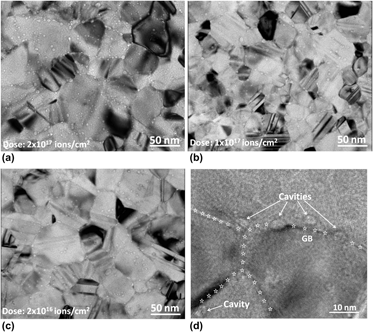Crossref Citations
This article has been cited by the following publications. This list is generated based on data provided by
Crossref.
Andrievski, R A
2014.
Nanostructures under extremes.
Physics-Uspekhi,
Vol. 57,
Issue. 10,
p.
945.
Andrievski, R.A.
2014.
Nanostructures under extremes.
Uspekhi Fizicheskih Nauk,
Vol. 184,
Issue. 10,
p.
1017.
Barr, Christopher M.
Barnard, Leland
Nathaniel, James E.
Hattar, Khalid
Unocic, Kinga A.
Szlurfarska, Izabela
Morgan, Dane
and
Taheri, Mitra L.
2015.
Grain boundary character dependence of radiation-induced segregation in a model Ni–Cr alloy.
Journal of Materials Research,
Vol. 30,
Issue. 9,
p.
1290.
Lach, Timothy G.
Ekiz, Elvan H.
Averback, Robert S.
Mara, Nathan A.
and
Bellon, Pascal
2015.
Role of interfaces on the trapping of He in 2D and 3D Cu–Nb nanocomposites.
Journal of Nuclear Materials,
Vol. 466,
Issue. ,
p.
36.
Vattré, A.
Jourdan, T.
Ding, H.
Marinica, M.-C.
and
Demkowicz, M. J.
2016.
Non-random walk diffusion enhances the sink strength of semicoherent interfaces.
Nature Communications,
Vol. 7,
Issue. 1,
Muntifering, Brittany
Blair, Sarah Jane
Gong, Cajer
Dunn, Aaron
Dingreville, Remi
Qu, Jianmin
and
Hattar, Khalid
2016.
Cavity Evolution at Grain Boundaries as a Function of Radiation Damage and Thermal Conditions in Nanocrystalline Nickel.
Materials Research Letters,
Vol. 4,
Issue. 2,
p.
96.
Liu, W.B.
Ji, Y.Z.
Tan, P.K.
Zhang, C.
He, C.H.
and
Yang, Z.G.
2016.
Microstructure evolution during helium irradiation and post-irradiation annealing in a nanostructured reduced activation steel.
Journal of Nuclear Materials,
Vol. 479,
Issue. ,
p.
323.
Andrievski, Rostislav A.
and
Khatchoyan, Arsen V.
2016.
Nanomaterials in Extreme Environments.
Vol. 230,
Issue. ,
p.
27.
Muntifering, Brittany
Fang, Youwu
Leff, Asher C.
Dunn, Aaron
Qu, Jianmin
Taheri, Mitra L.
Dingreville, Remi
and
Hattar, Khalid
2016.
In situ Transmission Electron Microscopy He+ implantation and thermal aging of nanocrystalline iron.
Journal of Nuclear Materials,
Vol. 482,
Issue. ,
p.
139.
Foley, Daniel
and
Tucker, Garritt J
2016.
Quantifying grain boundary damage tolerance with atomistic simulations.
Modelling and Simulation in Materials Science and Engineering,
Vol. 24,
Issue. 7,
p.
075011.
Liu, Wenbo
Ji, Yanzhou
Tan, Pengkang
Zang, Hang
He, Chaohui
Yun, Di
Zhang, Chi
and
Yang, Zhigang
2016.
Irradiation Induced Microstructure Evolution in Nanostructured Materials: A Review.
Materials,
Vol. 9,
Issue. 2,
p.
105.
Xiao, XiaZi
Chu, HaiJian
and
Duan, HuiLing
2016.
Effect of grain boundary on the mechanical behaviors of irradiated metals: a review.
Science China Physics, Mechanics & Astronomy,
Vol. 59,
Issue. 6,
Gigax, Jonathan G.
Kim, Hyosim
Chen, Tianyi
Garner, F.A.
and
Shao, Lin
2017.
Radiation instability of equal channel angular extruded T91 at ultra-high damage levels.
Acta Materialia,
Vol. 132,
Issue. ,
p.
395.
Han, Wei‐Zhong
Ding, Ming‐Shuai
Narayan, R. Lakshmi
and
Shan, Zhi‐Wei
2017.
In Situ Study of Deformation Twinning and Detwinning in Helium Irradiated Small‐Volume Copper.
Advanced Engineering Materials,
Vol. 19,
Issue. 12,
Chakraborty, Debajit
and
Aidhy, Dilpuneet S.
2017.
Cr-induced fast vacancy cluster formation and high Ni diffusion in concentrated Ni-Fe-Cr alloys.
Journal of Alloys and Compounds,
Vol. 725,
Issue. ,
p.
449.
Barr, Christopher M.
Li, Nan
Boyce, Brad L.
and
Hattar, Khalid
2018.
Examining the influence of grain size on radiation tolerance in the nanocrystalline regime.
Applied Physics Letters,
Vol. 112,
Issue. 18,
Zhang, Xinghang
Hattar, Khalid
Chen, Youxing
Shao, Lin
Li, Jin
Sun, Cheng
Yu, Kaiyuan
Li, Nan
Taheri, Mitra L.
Wang, Haiyan
Wang, Jian
and
Nastasi, Michael
2018.
Radiation damage in nanostructured materials.
Progress in Materials Science,
Vol. 96,
Issue. ,
p.
217.
Cunningham, W. Streit
Gentile, Jonathan M.
El-Atwani, Osman
Taylor, Chase N.
Efe, Mert
Maloy, Stuart A.
and
Trelewicz, Jason R.
2018.
Softening due to Grain Boundary Cavity Formation and its Competition with Hardening in Helium Implanted Nanocrystalline Tungsten.
Scientific Reports,
Vol. 8,
Issue. 1,
Ortún-Palacios, Jaime
Locci, Antonio Mario
Delogu, Francesco
and
Cuesta-López, Santiago
2018.
Self-healing ability assessment of irradiated multilayered composites: A continuum approach.
Journal of Nuclear Materials,
Vol. 512,
Issue. ,
p.
391.
Yang, Y.
Frazer, D.
Balooch, M.
and
Hosemann, P.
2018.
Irradiation damage investigation of helium implanted polycrystalline copper.
Journal of Nuclear Materials,
Vol. 512,
Issue. ,
p.
137.
